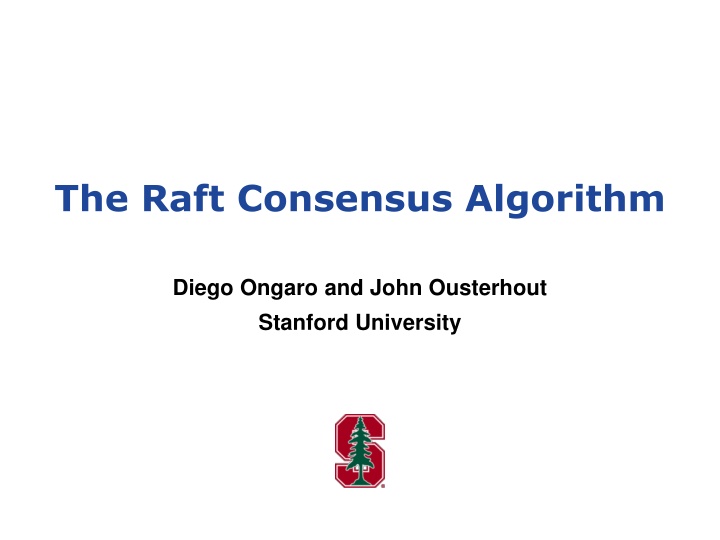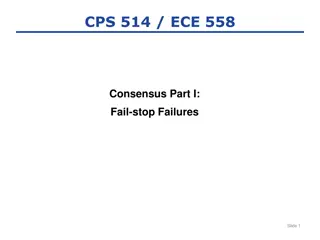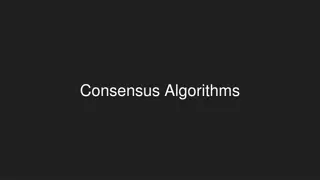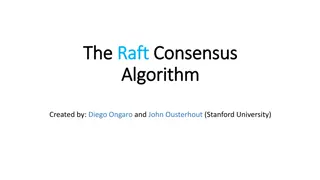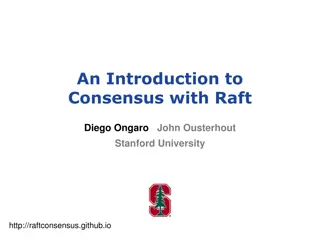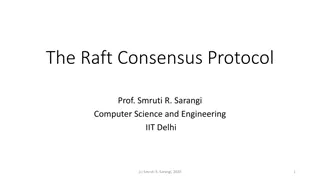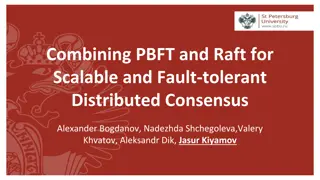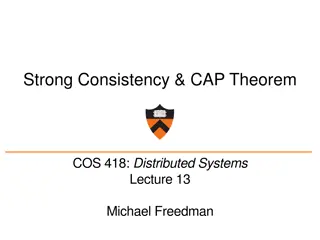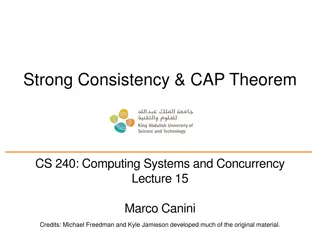The Raft Consensus Algorithm: Simplifying Distributed Consensus
Consensus in distributed systems involves getting multiple servers to agree on a state. The Raft Consensus Algorithm, designed by Diego Ongaro and John Ousterhout from Stanford University, aims to make achieving consensus easier compared to other algorithms like Paxos. Raft utilizes a leader-based approach where a single server is in charge, simplifying normal operation and leader changes in the system. The goal of Raft is to ensure replicated logs and proper log replication across servers, enabling consistent and fault-tolerant storage systems.
Download Presentation

Please find below an Image/Link to download the presentation.
The content on the website is provided AS IS for your information and personal use only. It may not be sold, licensed, or shared on other websites without obtaining consent from the author.If you encounter any issues during the download, it is possible that the publisher has removed the file from their server.
You are allowed to download the files provided on this website for personal or commercial use, subject to the condition that they are used lawfully. All files are the property of their respective owners.
The content on the website is provided AS IS for your information and personal use only. It may not be sold, licensed, or shared on other websites without obtaining consent from the author.
E N D
Presentation Transcript
The Raft Consensus Algorithm Diego Ongaro and John Ousterhout Stanford University
What is Consensus? Consensus: get multiple servers to agree on state Solutions typically handle minority of servers failing == master-slave replication that can recover from master failures safely and autonomously Used in building consistent storage systems Top-level system configuration Sometimes manages entire database state (e.g., Spanner) Examples: Chubby, ZooKeeper, Doozer October 2013 Raft Consensus Algorithm Slide 2
Raft: making consensus easier Consensus widely regarded as difficult Dominated by an algorithm called Paxos Raft designed to be easier to understand User study showed students learn Raft better 25+ implementations of Raft in progress on GitHub See http://raftconsensus.github.io Bloom, C#, C++, Clojure, Elixir, Erlang, F#, Go, Haskell, Java, Javascript, OCaml, Python, Ruby October 2013 Raft Consensus Algorithm Slide 3
Single Server Clients z 6 Hash Table x y z 1 2 6 Server October 2013 Raft Consensus Algorithm Slide 4
Single Server Clients z 6 State Machine Server October 2013 Raft Consensus Algorithm Slide 5
Single Server Clients z 6 State Machine Server Log x 3 y 2 x 1 z 6 October 2013 Raft Consensus Algorithm Slide 6
Goal: Replicated Log Clients z 6 Consensus Module State Machine Consensus Module State Machine Consensus Module State Machine Servers Log Log Log x 3 y 2 x 1 z 6 x 3 y 2 x 1 z 6 x 3 y 2 x 1 z 6 Replicated log All servers execute same commands in same order replicated state machine Consensus module ensures proper log replication System makes progress as long as any majority of servers are up Failure model: fail-stop (not Byzantine), delayed/lost messages October 2013 Raft Consensus Algorithm Slide 7
Approaches to Consensus Two general approaches to consensus: Symmetric, leader-less: All servers have equal roles Clients can contact any server Asymmetric, leader-based: At any given time, one server is in charge, others accept its decisions Clients communicate with the leader Raft uses a leader: Decomposes the problem (normal operation, leader changes) Simplifies normal operation (no conflicts) More efficient than leader-less approaches October 2013 Raft Consensus Algorithm Slide 8
Raft Overview 1. Leader election: Select one of the servers to act as leader Detect crashes, choose new leader 2. Normal operation (log replication) Leader takes commands from clients, appends them to its log Leader replicates its log to other servers (overwriting inconsistencies) 3. Safety Need committed entries to survive across leader changes Define commitment rule, rig leader election October 2013 Raft Consensus Algorithm Slide 9
Server States At any given time, each server is either: Leader: handles all client interactions, log replication At most 1 viable leader at a time Follower: completely passive replica (issues no RPCs, responds to incoming RPCs) Candidate: used to elect a new leader timeout, start election receive votes from majority of servers start Follower Candidate Leader October 2013 Raft Consensus Algorithm Slide 10
Terms Term 1 Term 2 Term 3 Term 4 Term 5 time Elections Split Vote Normal Operation Time divided into terms: Election Normal operation under a single leader At most 1 leader per term Some terms have no leader (failed election) Each server maintains current term value Key role of terms: identify obsolete information October 2013 Raft Consensus Algorithm Slide 11
Heartbeats and Timeouts Servers start up as followers Followers expect to receive RPCs from leaders or candidates If election timeout elapses with no RPCs: Follower assumes leader has crashed Follower starts new election Timeouts typically 100-500ms Leaders must send heartbeats to maintain authority October 2013 Raft Consensus Algorithm Slide 12
Election Basics Upon election timeout: Increment current term Change to Candidate state Vote for self Send RequestVote RPCs to all other servers, wait until either: 1. Receive votes from majority of servers: Become leader Send AppendEntries heartbeats to all other servers 2. Receive RPC from valid leader: Return to follower state 3. No-one wins election (election timeout elapses): Increment term, start new election Slide 13
Election Properties Safety: allow at most one winner per term Each server gives out only one vote per term (persist on disk) Two different candidates can t accumulate majorities in same term Voted for candidate A B can t also get majority Servers Liveness: some candidate must eventually win Choose election timeouts randomly from, e.g., 100-200ms range One server usually times out and wins election before others wake up October 2013 Raft Consensus Algorithm Slide 14
Log Structure log index 1 2 1 3 1 4 2 5 3 6 3 7 3 8 3 term 1 leader x 3 y 2 x 1 z 6 z 0 y 9 y 1 x 4 command 1 1 1 2 3 x 3 y 2 x 1 z 6 z 0 1 1 1 2 3 3 3 3 x 3 y 2 x 1 z 6 z 0 y 9 y 1 x 4 followers 1 1 x 3 y 2 1 1 1 2 3 3 3 x 3 y 2 x 1 z 6 z 0 y 9 y 1 committed entries Log entry = index, term, command Log stored on stable storage (disk); survives crashes October 2013 Raft Consensus Algorithm Slide 15
Normal Operation Client sends command to leader Leader appends command to its log Leader sends AppendEntries RPCs to followers Once new entry safely committed: Leader applies command to its state machine, returns result to client Catch up followers in background: Leader notifies followers of committed entries in subsequent AppendEntries RPCs Followers apply committed commands to their state machines Performance is optimal in common case: One successful RPC to any majority of servers October 2013 Raft Consensus Algorithm Slide 16
Log Consistency High level of coherency between logs: If log entries on different servers have same index and term: They store the same command The logs are identical in all preceding entries 1 2 1 3 1 4 2 5 3 6 3 1 x 3 y 2 x 1 z 6 z 0 y 9 1 1 1 2 3 4 x 3 y 2 x 1 z 6 z 0 x 4 If a given entry is committed, all preceding entries are also committed October 2013 Raft Consensus Algorithm Slide 17
AppendEntries Consistency Check Each AppendEntries RPC contains index, term of entry preceding new ones Follower must contain matching entry; otherwise it rejects request Implements an induction step, ensures coherency 1 2 3 4 5 1 1 1 2 3 leader x 3 y 2 x 1 z 6 z 0 AppendEntries succeeds: matching entry 1 1 1 2 follower x 3 y 2 x 1 z 6 1 1 1 2 3 leader x 3 y 2 x 1 z 6 z 0 AppendEntries fails: mismatch 1 1 1 1 follower x 3 y 2 x 1 x 4 October 2013 Raft Consensus Algorithm Slide 18
Log Inconsistencies Leader changes can result in tmp. log inconsistencies: log index leader for term 8 1 2 3 4 5 6 7 8 9 10 11 12 1 1 1 4 4 5 5 6 6 6 (a) 1 1 1 4 4 5 5 6 6 Missing Entries (b) 1 1 1 4 (c) 1 1 1 4 4 5 5 6 6 6 6 possible followers (d) 1 1 1 4 4 5 5 6 6 6 7 7 Extraneous Entries (e) 1 1 1 4 4 4 4 (f) 1 1 1 2 2 2 3 3 3 3 3 October 2013 Raft Consensus Algorithm Slide 19
Repairing Follower Logs Leader keeps nextIndex for each follower: Index of next log entry to send to that follower When AppendEntries consistency check fails, decrement nextIndex and try again: nextIndex log index 1 2 3 4 5 6 7 8 9 10 11 12 leader for term 7 1 1 1 4 4 5 5 6 6 6 (a) 1 1 1 4 followers (b) 1 1 1 2 2 2 3 3 3 3 3 When follower overwrites inconsistent entry, it deletes all subsequent entries: follower (b) after 1 1 1 4 October 2013 Raft Consensus Algorithm Slide 20
Safety Requirement Any two committed entries at the same index must be the same. Leader marks entry committed Entry present in every future leaders log Restrictions on commitment Restrictions on leader election October 2013 Raft Consensus Algorithm Slide 21
Picking Up-to-date Leader During elections, candidate must have most up-to- date log among electing majority: Candidates include log info in RequestVote RPCs (length of log & term of last log entry) Voting server denies vote if its log is more up-to-date: Same last term but different lengths: Different last terms: 1 2 3 4 5 1 2 3 4 5 more up-to-date 1 1 1 2 2 1 1 1 5 1 1 1 2 1 1 1 2 October 2013 Raft Consensus Algorithm Slide 22
Committing Entry from Current Term Case #1/2: Leader decides entry in current term is committed 1 2 3 4 5 6 Leader for term 2 s1 1 1 2 2 s2 1 1 2 AppendEntries just succeeded s3 1 1 2 s4 1 1 Can t be elected as leader for term 3 s5 1 1 Majority replication makes entry 3 safe: Leader marks entry committed Entry present in every future leaders log October 2013 Raft Consensus Algorithm Slide 23
Committing Entry from Earlier Term Case #2/2: Leader is trying to finish committing entry from an earlier term 1 2 3 4 5 6 Leader for term 4 s1 1 1 2 4 s2 1 1 2 AppendEntries just succeeded s3 1 1 2 s4 1 1 Could be elected as leader for term 5! s5 1 1 3 3 3 Entry 3 not safely committed: Leader marks entry committed Entry present in every future leaders log October 2013 Raft Consensus Algorithm Slide 24
New Commitment Rules New leader may not mark old entries committed until it has committed an entry from its current term. 1 2 3 4 5 Leader for term 4 s1 1 1 2 4 s2 1 1 2 4 Once entry 4 committed: s5 cannot be elected leader for term 5 Entries 3 and 4 both safe s3 1 1 2 4 s4 1 1 s5 1 1 3 3 3 Combination of election rules and commitment rules makes Raft safe October 2013 Raft Consensus Algorithm Slide 25
Raft Summary 1. Leader election 2. Normal operation 3. Safety More at http://raftconsensus.github.io: Many more details in the paper (membership changes, log compaction) Join the raft-dev mailing list Check out the 25+ implementations on GitHub Diego Ongaro @ongardie Slide 26
